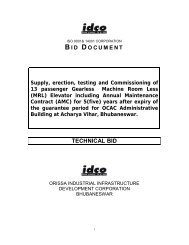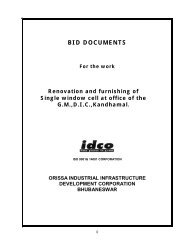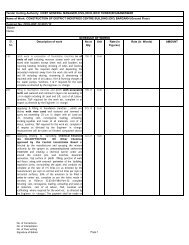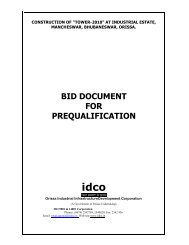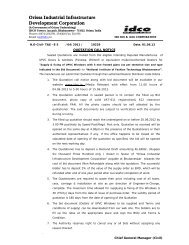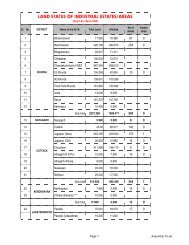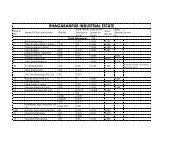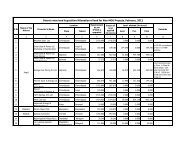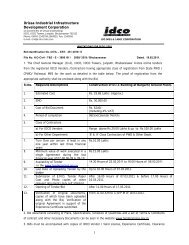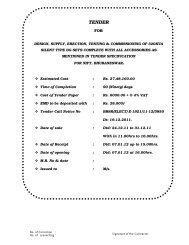BID DOCUMENT - IDCO
BID DOCUMENT - IDCO
BID DOCUMENT - IDCO
You also want an ePaper? Increase the reach of your titles
YUMPU automatically turns print PDFs into web optimized ePapers that Google loves.
(b)<br />
(c)<br />
(d)<br />
(e)<br />
1.10 CURING<br />
(a)<br />
No concerting shall begin until the required number of vibrators are available, all being tested and found to<br />
be in good working condition at the work site.<br />
In general the number of vibrators available for use shall be as follows<br />
On vibrator for each four cubic meter of concrete placed per hour and one stand by vibrator for each three<br />
vibrators in service but in any case at least two vibrators in good working order shall be present at the<br />
forms.<br />
Immersion vibrators shall be inserted and withdrawn slowly at a uniform rate of approximately 10mm per<br />
second. Compaction shall be deemed to be completed when cement mortar appears in a circle round the<br />
vibrator. The immersion vibrators shall be inserted at intervals determined by area of mortar shown after the<br />
previous vibrator with a certain allowance made for over lapping. The immersion vibrators shall not be<br />
allowed to come into contract with the formwork and the reinforcement.<br />
Pan vibrators shall be placed on the surface of the concrete, which shall have previously been tamped and<br />
leveled but left slightly high to allow for settlement during compacting until cement mortar appears under the<br />
pan. The vibrators shall then be lifted and placed on the adjoined area and the operation shall be repeated<br />
until the whole surface has been compacted. Alternatively a vibrating screed spanning the full width of the<br />
panel shall be used.<br />
In all case the placing of concrete shall be sufficiently ahead of the vibrators so that the mass of concrete<br />
beyond the vibrators is sufficient to a stand flooring while vibration is in progress. On the other hand the<br />
concrete shall be fully compacted before initial set is attained.<br />
As soon the freshly placed concrete has hardened sufficiently to withstand such treatment without damage<br />
the exposed surfaces shall be completely covered with wet gunny bags or any other means approved by<br />
the engineer and shall be kept thoroughly wet continuously by generous applications of water every two<br />
hours for period of 14 days. Water shall be allowed to run down between the forms and the formed<br />
concrete surfaces. Floor slabs shall have water impounded on them for period of at least 14 days after<br />
placing. Any excess water or cream that may have come to the surface shall first be removed dry cement or<br />
dry mixture of cement and sand shall not be sprinkled on the surface to absorb such access moisture.<br />
1.11 FORMWORK<br />
(a)<br />
(b)<br />
(c)<br />
(I)<br />
(ii)<br />
(d)<br />
(e)<br />
All form work shall be erected true to line and level as shall be adequately secured and braced to prevent<br />
deflection or movement during the placing tamping or vibration of the concrete and shall be sufficiently tight<br />
to prevent loss of liquid from the concrete.<br />
If for any reason the form work moved after the concrete has been placed thus disturbing the freshly placed<br />
concrete or if the concrete is found to be defective in alignment, the contractor may be ordered to take out<br />
and replace such concrete without extra payment. All the faces of form work in contract with concrete shall<br />
be smooth and free form surface imperfections.<br />
The formwork shall be constructed with any of the following materials depending of suitability.<br />
Steel shuttering of 14 gauges for RCC works especially in roof/ floor slab and columns.<br />
As described in Instruction to Bidder.<br />
Waterproof plywood of approved manufacture 18mm thick securely fixed to timber may be used after<br />
approval by the engineer in charge.<br />
The height of formwork will be as follows<br />
Timber formwork should not exceed the height of 1200mm<br />
Steel formwork should not exceed the height of 2150mm<br />
The use of wire passing through the concrete for the purpose of securing form will not be permitted. Bolts<br />
may be used but their number shall be kept to the minimum required to secure the formwork rigidly. The<br />
bolts shall not be less than 13mm dia. The hole left by bolts shall be cleaned and filled with cement mortar<br />
containing waterproofing materials of approached quality.<br />
Before concreting all forms shall be cleaned and treated with approved mould oil to prevent adhesion of the<br />
concrete care being exercised to ensure that no oil falls on the set concrete or reinforcement provision shall<br />
28



